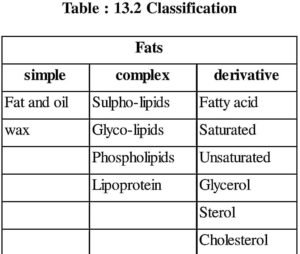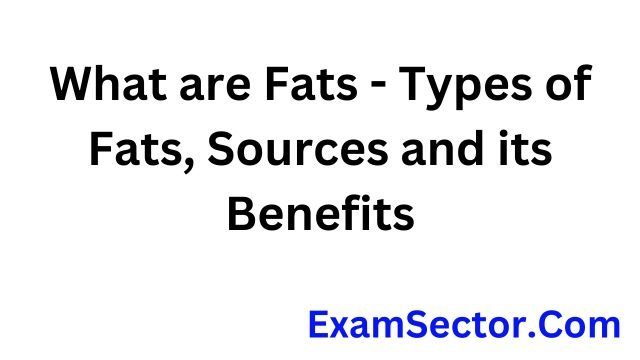What are Fats – Types of Fats, Sources and its Benefits
What are Fats —
- Fats are a concentrated source of energy. Fat is an organic compound which is insoluble in water but soluble in organic solvents such as chloroform, benzene, ether, etc. These are smooth to touch.
Chemical Formation of Fats —
- Carbon, hydrogen and oxygen are main elements of fats. The quantity of oxygen is less than that of carbon and hydrogen. Fats are divided into 3 parts.

1. Simple fat—
It is formed by combination of glycerol and fatty acids.
Glycerol + fatty acid = simple fat
1 molecule 3 molecules
- Neutral fat— Fat and oil are included in this category. Fats are the substances that condense at 20° Celsius to become solids while those which are in liquid state at this temperature are called oil. Fats and oils are made up of glycerol and fatty acids. Glycerol + fatty acid = fat and oil ‘
- Wax— Wax is a lipid made up of a chain of alkanes or esters from alcohols and fatty acids.
2. Compound fat—
when some organic compounds combine with fatty acids and glycerol compound fats are formed.
Fat + = compound fat
(Glycerol + fatty acid) + (organic or inorganic substance)
- Fat + carbohydrates + sulphuric acid = sulpholipid
- Fatty acid + glycerol+ carbohydrates = glycolipid
- Fatty acid + glycerol + phosphoric acid + nitrogen bases = phospholipids
- Fat + protein = lipoprotein
3. Derivative fat —
The new products formed by the hydrolysis of simple and compound fat are called derivative fat.
(i) Fatty acid— Fatty acids are obtained by hydrolysis of fats. Fatty acids are differentiated on the basis of difference in composition occurring at different positions of carbon molecules and hydrogen molecules.
- Saturated fatty acid— A saturated fat is a type of fat, in which the fatty acids have single bonds. For example, butyric acid, palmitic acid, etc.
- Unsaturated fatty acid—An unsaturated fat is a fat or fatty acid in which there is at least one double bond within the fatty acid chain.Thus, carbon and hydrogen are bonded by double bonds. Examples: folic acid, linoleic acid, etc.
(ii) Glycerol— Glycerol obtained by hydrolysis of fat performs the function of energy production.
(iii) Sterol— Chemically sterol is not related to fat but fatty acid and alcohol are present in it. These are the organic compounds which are made up of mixed cyclic conformations. Sterols can be divided into following categories on the basis of source—
- (a) Cholesterol— It is found in the animal world. It is found in blood, liver, adrenal glands, pituitary gland, brain and peripheral nerves of humans and animals. Cholesterol is present in yellow part of eggs, butter, ghee, cottage cheese, meat, liver, etc.
- (b) Ergosterol— This fat is mainly found in yeast. It is also present in the human body under the skin where it gets converted into vitamin D in the presence of ultraviolet rays of the sun.
Functions of Fats —
- Providing energy— Fat is a condensed form of energy. 1 gram fat gives 9 kilocalories energy. Therefore fat provides twice the energy than carbohydrates and protein. Because of high density and low solubility fat remains stored in fatty tissues and they get oxygenated to provide energy whenever need arises.
- Providing protection to soft organs of the body— Fat remains stored in fatty tissues under the skin and acts as a thick layer. There is a double layer of fat on all soft organs of the body such as heart, liver, lungs, kidneys, and pancreas. This double layer acts as a protective layer.
- Controlling body temperature— The fat layer under our skin acts as a thermal barrier. Thus, fat is helpful in controlling and regulating body temperature.
- As a source of soluble vitamin— Fat is the best source of obtaining fat soluble vitamins ‘A, ‘D, ‘E’, ‘K. These vitamins are easily absorbed in the presence of fats.
- Procurement of essential fatty acids— Some essential fatty acids are not formed in the body but they are important for the health of body and protection of skin and fat-rich food makes it possible.
Other functions— Fat is digested slowly. The stomach does not get rid of it and one does not feel hungry. In fact, fat reduces the secretion of gastric Jjuice in stomach. Fat helps in keeping skin smooth and healthy. It acts as a lubricant of alimentary canal and it helps in keeping the passage of stomach and intestines smooth. In addition to this, it helps in production of other important products.
Source— fats and oils are obtained from both animal and plant sources.
Plant source— cereals, lentils, groundnuts, sesame, coconut, mustard, dry fruits such as cashew, almonds and vegetable oil obtained from them.
Animal source— ghee, butter, cream, milk, milk products, fish oil, animal fat, etc.
Fats Effects of deficiency —
Following are the effects of deficiency of fat in food—
- Decrease in availability of energy to the body
- Normal growth stops
- Dryness, roughness, dullness of skin
- Phrynoderma
- Decrease in working capacity of cells
- Lack of essential fatty acids such as linoleic acid, linolenic acid, arachidonic acid and fat soluble vitamins A, D, E, K.
Effects of excess of fat—
- Obesity— Obesity is a condition where a person has accumulated more body fat which increase weight of the body.
- Diabetes— Excess consumption of fat and carbohydrates leads to excess formation of glucose. Glucose can be stored to a limited extent in the blood. Diabetes is a disorder of the metabolism causing excessive thirst and the production of large quantity of urine.
- Heart-related diseases— Excess of fat in blood causes an increase in cholesterol. Excess of cholesterol gets accumulated in the inner walls of arteries. It is called Atherosclerosis. s and this has a direct effect on the heart which increases As a result, blood pressure increast the chances of heart attacks.
Home Science Latest Post :- Click Here
Oils and Fats Questions and Answers :-
1. Melting point of fat is _________ and melting point of oil is ________
a) Higher, higher
b) Lower, lower
c) Higher, lower
d) Lower, higher
Click to show/hide
2. Which of the following is an example of fats?
a) Glyceryl trioleate
b) Vegetable ghee
c) Coconut oil
d) Groundnut oil
Click to show/hide
3. Select the incorrect statement from the following option.
a) Oils are saturated triglyceride
b) Oils have lower melting points
c) Oils are liquid at room temperature
d) Examples of oils are glyceryl trioleate, coconut oil, olive oil, etc
Click to show/hide
4. Which of the following is not a suitable solvent for oils and fats?
a) Benzene
b) CCl4
c) CHCl3
d) Water
Click to show/hide
5. Oils and fats are good conductors of heat and electricity.
a) True
b) False
Ans. ⇒ ????
